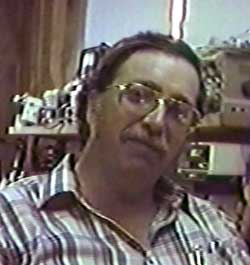
Frank Golden

Frank Golden
|
Golden's "Conditioned Vacuum" Motor We have written of this one elsewhere, but will just state it again here to be complete. In the latter 1970s and 1980s, I worked extensively with a very fine colleague, Frank Golden. Frank worked on many different kinds of projects, such as a "free A-potential" antenna where the antenna signal is freed from its magnetic field B but still possesses the magnetic vector potential. He also did work on underwater communication, scalar EM antennas, and — as we called it at the time — scalar EM interferometers. He worked on the Prioré project, and in fact went to France with our team (I was unable to go) and met Prioré face to face. He also inspected Prioré's lab, including the one with the truly giant plasma tube. Frank also worked on free energy devices of several kinds. One of his motors exhibited a very unique phenomenon. Frank developed the motor over a period of some five years. Slowly its efficiency rose, until eventually it clearly produced COP>1.0. In fact it's measured COP was 1.67. Then Frank moved several hundred miles away, and of course took his shop and motors with him. In the new location, imagine our total astonishment when Frank found that the same motor now produced COP<1.0! Fortunately, at the time we were also working with Professor Bill Tiller, noted scientist and former head of the Materials Science Department at Stanford University. Tiller was already familiar with the phenomenon that devices that function by more subtle EM energy often require special conditioning of their local vacuum spacetime. He expressed this odd phenomenon as "an archetype must first be created and grown for the machine to function efficiently." Since we now understand that matter and its dynamics affects spacetime (local vacuum) and its dynamics, and vice versa, then it is no longer so great a stretch of the imagination to see that, for "subtle" energy — i.e., energy which directly involves producing new curvatures of local ST — Tiller's structuring operation indeed exists. Tiller himself had previously experimented with such an effect for several years in his lab at Stanford, gradually growing the effect to greater magnitude — just as Frank had "grown" the structured local vacuum slowly, so that his machine's efficiency increased slowly over the years. So what had been lost in the move, was a 5-year-long conditioning (structuring) of the local Tennessee ambient vacuum potential in order for the device to work. We did not have another five years available to grow it back in Maryland! Previously we had been entirely unaware that one can sometimes condition the local vacuum and the potentials in the local matter in the area with a particular dynamic form. Given the local conditioning, a motor with that form will then work in that vicinity where the form is present and recorded, but not necessarily elsewhere at an appreciable distance away where the form is not present in the background environment potentials. How to Deal With a "Conditioned Local Vacuum" Overunity Motor We now understand the mechanism for such "conditioning of the vacuum." We also now know what to do if an overunity machine is actually a machine of that type (many of them are not). In other words, we know how to convert it to a machine that will work anywhere, anytime. What you do is use the "outrigger spreading" method. First, you leave the original motor right where it is, and operate it almost continuously. You build several more just like it, and operate them right there beside it. With the vacuum already structured, these new motors will have a much-shortened "break-in" period where they adjust to accommodate the structured vacuum. In other words, the structured vacuum slowly works on them, slowly altering the dynamics of the motors at the deepest levels, even down to the quarks in the nucleons in the atomic nuclei of the materials in those motors. So you use the original motor as a "queen bee" and the location as the "bee hive". You then condition some more "queen bees" so you can set up some more-distant "bee hives". After the new queens are conditioned, you take them out to a distance (say, 150 to 200 miles) in about six directions (six is a good number because of some of the peculiar characteristics of a hexagon). When you see their efficiency falling back toward 1.0, stop before you reach 1.0, but are still at COP>1.0. Say, stop at about 1.1. or 1.2. Then operate those outrigger queens, and watch their efficiency gradually increase again. What you are doing is gradually spreading the conditioning of the vacuum. Eventually they will "come up" to par, and be equal to your original queen bee, still operating back at the original hive. Then grow some more new queens at all the hives, and outrigger again. With several repetitions of outriggering and hive spreading and producing new queen bees, the conditioning of the vacuum/spacetime will eventually spread around the entire earth. You will have conditioned (1) the master potential of the entire Earth, (2) the local spacetime region occupied by the entire Earth, and (3) the continuous dynamic interactions of the two. In short, now you will have created an "Earth archetype" for your engine, to use Tiller's terminology. Thereafter, a motor built just like that will work at overunity efficiency anywhere on Earth. You can shut it down, store it for a year, move it five thousand miles, turn in on again, and it will work like a charm. It will work like a charm the moment it comes off the production line. Again, this queen bee and bee hive concept — and Tiller's "growing the archetype" by conditioning the local spacetime — is not in your textbook. And unless your professor was Bill Tiller, he probably did not know it either. |